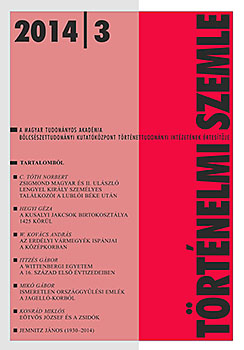Az erdélyi vármegyék ispánjai a középkorban
The Ispáns of the Transylvanian Counties in the Middle Ages
Author(s): András W. KovácsSubject(s): Geography, Regional studies, Political history, Middle Ages
Published by: Magyar Tudományos Akadémia Bölcsészettudományi Kutatóközpont Történettudományi Intézet
Keywords: Ispán; Transylvania; county; middle ages; history;
Summary/Abstract: In the seven counties of Transylvania (Belső-Szolnok, Doboka, Fehér, Hunyad, Kolozs, Küküllő, Torda) it was the voevode of Transylvania, the royal dignitary governing the province, who appointed the ispáns from the ranks of his own retainers from the early 14th century. Although their appointment was revocable at any time, they were not necessarily dismissed upon the removal of their lord from the voevodship. The fact that some among them turned up successively at the head of several counties may be explained by ties of service and the experience accumulated while in office. In certain cases, however, the ispán was not in the service of the voevode but in that of his deputy. In the second half of the 15th century and in the early 16th the ispáns of Hunyad county were the retainers of those who owned the castle of Hunyad and their castellans there, but they also owed obedience to the voevode in matters affecting the defense of Transylvania. The decree of the Transylvanian estates enacted at the assembly of Torda in 1540, which ordered that the alispán should be elected by the county nobility, wanted to break with the preceding practice. Sometimes the deputy-voevode held the ispanate of one of the counties. In the 14th century the deputy-voevodes were simultaneously ispáns of Fehér county; the last reference to them as such comes from 1406. By 1435 the latest they had certainly ceased to function as ispáns of Fehér. Also in the 14th century, the ispáns likewise acted as castellans of a castle entrusted to their care or of one in a neighboring county but belonging to the voevode’s honor. From the second half of the 15th century the Transylvanian ispáns only rarely assumed the castellanship of either of the two castles (Küküllővár [Cetatea de Baltă, Romania] and Déva [Deva, Romania]), which remained attached to the voevode’s honor, during their office holding as ispán. Although the great majority of the Transylvanian ispáns were landed in the province, they were not necessarily appointed to those counties where the bulk of their estates lay. The voevode could occasionally entrust two counties to the same ispán. Such counties were always immediate neighbors, such as the pairs Belső-Szolnok– Doboka, Doboka–Kolozs, or Kolozs–Torda. The practice of appointing simultaneously two (or occasionally more) ispáns to govern the same county began shortly before the middle of the 15th century, and was continued thereafter. It presumably introduced at the county level a system already in operation, albeit not excusively, with regard to the national offices. The ispáns were occasionally referred to as alispáns (i.e. vice-ispán), and titles could vary in the case of one and the same person; the „alispáns” may consequently be also regarded as ispáns, with the sole exception of those isolated cases when ispán and alispán figure together in a charter. One finds no castle-owners among the ispáns, and their political role was extremely limited. In terms of landed wealth, the families most frequently employed belonged to what is commonly referred to as the county nobility, with a couple of estates or parts of estate laying in one, or at most two counties. They generally turn up in the charters as attorneys, arbitrators or „royal (voevodal) men” (royal/voevodal representatives). For those Transylvanian noblemen who decided on a career in the administration the offices of ispán and szolgabíró were the easiest to reach, and for several among them, indeed, these offered the only career possibility.
Journal: Történelmi Szemle
- Issue Year: 2014
- Issue No: 03
- Page Range: 407-421
- Page Count: 15
- Language: Hungarian

